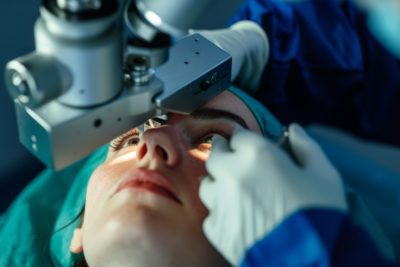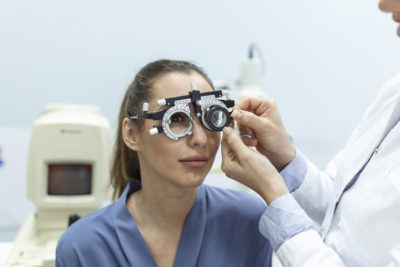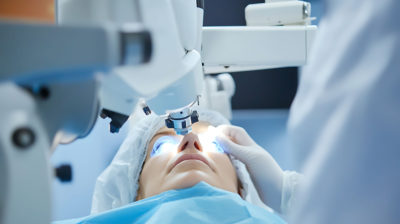In a world where technology and innovation continue to shape our lives, advancements in medical science have brought about transformative solutions for enhancing our quality of life. One such groundbreaking development is Monovision LASIK, a revolutionary procedure that offers individuals the freedom to enjoy clear vision for both near and far distances without the need for reading glasses. In this comprehensive article, we’ll delve into the intricacies of Monovision LASIK, exploring how it works, its benefits, potential drawbacks, and what individuals considering the procedure should know.
What is Monovision LASIK?
Monovision LASIK is a specialised laser eye surgery designed to correct presbyopia, a common age-related condition that results in a diminished ability to focus on close objects. Unlike traditional LASIK, which aims to correct distance vision, Monovision LASIK intentionally adjusts one eye for near vision and the other for distance vision. Essentially, the brain learns to rely on the eye that provides clear vision for a particular distance, allowing individuals to seamlessly transition between near and far vision without the need for reading glasses.
How Monovision LASIK Works
During the Monovision LASIK procedure, the surgeon uses laser technology to reshape the cornea of each eye differently. The dominant eye is typically corrected for distance vision, while the non-dominant eye is adjusted for near vision. This deliberate imbalance allows the brain to adapt to the varying visual needs, relying on the dominant eye for tasks like driving or watching TV and the non-dominant eye for reading or using a computer.
Benefits of Monovision LASIK
Reduced Dependence on Reading Glasses
The primary advantage of Monovision LASIK is the significant reduction in the need for reading glasses. Individuals who have undergone this procedure often find themselves liberated from the constant search for their glasses when reading a menu, a book, or using a smartphone.
1. Natural Vision Transition
The brain adapts remarkably well to Monovision, seamlessly transitioning between the two eyes for different tasks. Over time, patients report a natural and intuitive adjustment to this dual-vision setup.
2. Minimal Discomfort
Monovision LASIK is generally well-tolerated, and many individuals experience minimal discomfort during the recovery period. The procedure has a high satisfaction rate among those seeking a multifocal vision solution.
Considerations and Potential Drawbacks
-
Depth Perception
One potential drawback of Monovision LASIK is a compromise in depth perception. Some individuals may notice a slight reduction in their ability to perceive depth, especially in low-light conditions. However, the brain often compensates for this over time.
-
Adaptation Period
It’s crucial to understand that adapting to Monovision may take some time. While some individuals adjust quickly, others may require a few weeks for their brain to fully adapt to the new visual configuration.
-
Ongoing Ageing Changes
While Monovision LASIK can address presbyopia effectively, it doesn’t halt the natural ageing process of the eyes. Over time, additional vision changes may occur, and a touch-up procedure or the use of reading glasses for prolonged near tasks may be necessary.
Considerations for Potential Candidates
Before embarking on the journey of Monovision LASIK, individuals need to consider several factors
-
Personal Lifestyle:
Understanding one’s daily activities and visual requirements is crucial. Those heavily engaged in activities requiring sharp distance vision, such as driving or playing sports, may find Monovision LASIK particularly beneficial.
-
Trial with Contact Lenses:
Before committing to the surgical procedure, individuals can simulate Monovision using contact lenses. This allows for a trial period to assess how well they adapt to the visual changes and whether this approach suits their lifestyle.
-
Realistic Expectations:
While Monovision LASIK offers remarkable benefits, it’s essential for individuals to maintain realistic expectations. Some compromise in certain aspects of vision, such as depth perception, may occur, and understanding these potential changes is vital for overall satisfaction with the procedure.
-
Consultation with an Eye Care Professional:
Seeking guidance from a qualified eye care professional is paramount. They can assess the individual’s eye health, discuss the suitability of Monovision LASIK, and address any concerns or questions.
Post-Procedure Experience
After undergoing Monovision LASIK, the recovery process is typically swift, with many individuals experiencing improved vision within a few days. It’s common to follow a post-operative care plan provided by the surgeon, which may include the use of prescribed eye drops and avoiding strenuous activities for a specified period.
During the initial weeks, individuals may notice fluctuations in vision as their brain adapts to the new visual configuration. Regular follow-up appointments with the eye care professional are essential to monitor progress and address any concerns.
Potential Alternatives
While Monovision LASIK is an effective solution for many, some individuals may opt for alternative approaches to address presbyopia. These alternatives include multifocal or accommodating intraocular lenses for cataract surgery or the use of multifocal contact lenses. Each option has its advantages and considerations, and a thorough discussion with an eye care professional can help determine the most suitable choice.
Hence, Monovision LASIK stands as a groundbreaking solution for individuals seeking clear vision at both near and far distances without the constant reliance on reading glasses. While it may not be suitable for everyone, many have found immense satisfaction and improved quality of life through this innovative procedure. As with any medical decision, it’s crucial to consult with an experienced eye care professional to determine if Monovision LASIK is the right choice for individual needs and lifestyle. Embracing the future of vision correction, Monovision LASIK opens new possibilities for a glasses-free life, providing a clear and focused outlook on the world.








